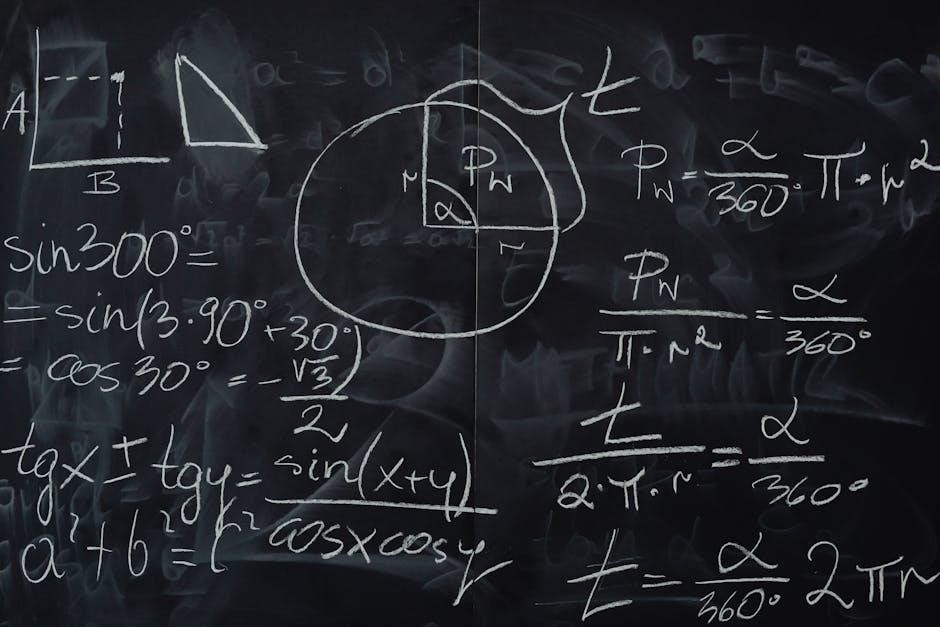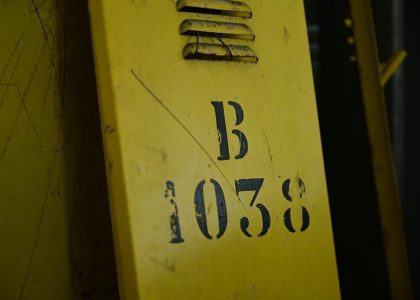Triangle congruence proofs are an essential part of geometry, enabling us to identify congruent triangles using various theorems like SSS, SAS, and ASA, ensuring accuracy in problem-solving.
1.1 What Are Triangle Congruence Proofs?
Triangle congruence proofs are methods used to demonstrate that two triangles are identical in shape and size. These proofs rely on corresponding parts (CPCTC) and specific theorems like SSS, SAS, ASA, AAS, and HL. By establishing congruency, we confirm that all corresponding sides and angles are equal. A worksheet on triangle congruence proofs provides structured exercises to practice identifying congruent triangles and applying the appropriate theorems. It helps students master geometric reasoning and logical argumentation, essential skills for advanced geometry topics.
1.2 Importance of Triangle Congruence in Geometry
Triangle congruence is fundamental in geometry as it establishes the equality of triangles, ensuring their sides and angles are identical. This concept is crucial for solving complex problems, constructing geometric shapes, and understanding spatial relationships. Congruence proofs validate the precision of geometric constructions and are essential in real-world applications like engineering and architecture. They also enhance problem-solving skills, teaching students to apply theorems logically and systematically. Mastering triangle congruence builds a strong foundation for advanced geometric principles and practical problem-solving in STEM fields.

Key Concepts in Triangle Congruence
Triangle congruence relies on understanding corresponding parts, theorems like SSS and SAS, and the CPCTC principle, which are foundational for proving triangle equality.
2.1 Corresponding Parts of Congruent Triangles (CPCTC)
Corresponding Parts of Congruent Triangles (CPCTC) states that if two triangles are proven congruent, their corresponding sides, angles, and segments are also congruent. This principle is fundamental in triangle congruence proofs as it allows the transfer of information from one triangle to another. For example, if triangle ABC is congruent to triangle XYZ, then side AB corresponds to side XY, and angle B corresponds to angle Y. This ensures that all corresponding elements are equal in measure, reinforcing the congruence of the triangles. CPCTC is a crucial tool in solving geometric problems and proofs.
2.2 Types of Triangle Congruence Theorems
There are several theorems that determine triangle congruence, including the Side-Side-Side (SSS), Side-Angle-Side (SAS), Angle-Side-Angle (ASA), Angle-Angle-Side (AAS), and Hypotenuse-Leg (HL) theorems. Each theorem provides specific criteria for proving triangles congruent. For instance, SSS requires three congruent sides, while SAS demands two sides and the included angle to be equal. ASA involves two angles and the included side, and AAS requires two angles and a non-included side. HL is used for right triangles, needing a congruent hypotenuse and one leg. These theorems offer structured methods to establish triangle congruence in geometric proofs.

Theorems Used in Triangle Congruence Proofs
The primary theorems used in triangle congruence proofs are SSS, SAS, ASA, AAS, and HL, each providing distinct criteria to establish triangle congruence.
3.1 Side-Side-Side (SSS) Congruence Postulate
The Side-Side-Side (SSS) Congruence Postulate states that if three sides of one triangle are congruent to three sides of another triangle, then the triangles are congruent. This postulate is fundamental in proving triangle congruence as it ensures that both triangles have identical sizes and shapes. When applying SSS, it is essential to verify that all corresponding sides are equal in length. This postulate is particularly useful when angles are not provided, relying solely on side lengths to establish congruence. It is one of the most straightforward and commonly used criteria in geometric proofs.
3.2 Side-Angle-Side (SAS) Congruence Postulate
The Side-Angle-Side (SAS) Congruence Postulate states that if two sides and the included angle of one triangle are congruent to two sides and the included angle of another triangle, then the triangles are congruent. This postulate is widely used in geometric proofs, especially when dealing with triangles that share a common angle. The SAS criterion is reliable because the included angle ensures the triangles’ shapes are identical. It is important to note that the angle must be between the two sides being compared, as this guarantees the triangles’ corresponding parts align perfectly, making them congruent.
3.3 Angle-Side-Angle (ASA) Congruence Postulate
The Angle-Side-Angle (ASA) Congruence Postulate states that if two angles and the included side of one triangle are congruent to two angles and the included side of another triangle, then the triangles are congruent. This postulate is useful when two angles and the side between them are known. Since the sum of angles in a triangle is always 180°, knowing two angles allows the third to be determined. Thus, ASA ensures triangles with identical angles and a shared side are congruent. This criterion is particularly helpful in proofs involving isosceles triangles or when angle relationships are prominent.
3.4 Angle-Angle-Side (AAS) Congruence Postulate
The Angle-Angle-Side (AAS) Congruence Postulate states that if two angles and a non-included side of one triangle are congruent to two angles and a non-included side of another triangle, then the triangles are congruent. This postulate relies on the fact that the sum of angles in a triangle is always 180°, allowing the third angle to be determined. AAS is particularly useful in proofs where two angles and a side not between them are known. It ensures triangles with matching angles and a corresponding side are congruent, making it a versatile tool in geometric proofs and problem-solving scenarios.
3.5 Hypotenuse-Leg (HL) Congruence Theorem
The Hypotenuse-Leg (HL) Congruence Theorem applies specifically to right triangles, proving their congruence if the hypotenuse and one leg of each triangle are congruent. This theorem is derived from the Pythagorean theorem, ensuring that the third side, the other leg, must also be congruent. It is a specialized case, primarily used when dealing with right-angled triangles, and it simplifies proving congruence by requiring only two corresponding sides—one of which must be the hypotenuse. This theorem is a direct consequence of the properties of right triangles, making it a valuable tool in geometric proofs and problem-solving involving right-angled figures.

Steps for Triangle Congruence Proofs
Begin by listing given information, identify congruent parts, apply the appropriate theorem (SSS, SAS, ASA, AAS, or HL), and conclude with CPCTC for corresponding sides and angles.
4.1 Writing the Givens
Writing the givens is the first step in any triangle congruence proof. It involves clearly stating all known information about the sides and angles of the triangles. This includes any congruent sides, angles, or other relevant details provided in the problem. By organizing the given information, it becomes easier to identify which congruence theorem applies. Accurate documentation ensures a logical flow, making the proof more coherent and easier to follow. Properly noting the givens also helps in avoiding assumptions and ensures that each step is justified, leading to a solid and valid proof.
4.2 Identifying Congruent Parts
Identifying congruent parts is a critical step in triangle congruence proofs. It involves determining which sides and angles in the two triangles are equal. This step follows the givens and helps establish the foundation for applying a congruence theorem. By carefully analyzing the given information, one can identify corresponding sides and angles that are congruent, which is essential for proving the triangles’ congruence. This process ensures that the proof is logical and aligns with the appropriate theorem, such as SSS, SAS, or ASA. Accurate identification of congruent parts is vital for the validity of the proof.
4.3 Applying the Appropriate Theorem
Applying the appropriate theorem is crucial in triangle congruence proofs. Once the givens and congruent parts are identified, the next step is to determine which theorem aligns with the information provided. Commonly used theorems include SSS, SAS, ASA, AAS, and HL. Each theorem has specific conditions that must be met, such as the number of sides and angles required. By carefully matching the given information to the correct theorem, a valid proof can be constructed. This step ensures that the reasoning is sound and logically supports the conclusion that the triangles are congruent.
4.4 Conclusion Using CPCTC
After proving that two triangles are congruent using an appropriate theorem, the final step is to apply the Corresponding Parts of Congruent Triangles are Congruent (CPCTC) concept. This principle allows us to conclude that any corresponding sides, angles, or other elements of the triangles are also congruent. By stating “CPCTC,” we validate that all corresponding parts are equal, reinforcing the triangles’ congruence. This step ensures the proof is complete and logically sound, providing a clear conclusion to the argument.

Types of Proofs in Triangle Congruence
Triangle congruence proofs can be presented in various formats, including two-column proofs, paragraph proofs, and flowchart proofs, each offering a structured approach to demonstrating triangle congruence effectively.
5.1 Two-Column Proofs
Two-column proofs are a structured method of demonstrating triangle congruence by listing each step alongside its corresponding reason. The left column contains statements, while the right column provides justifications, such as congruence theorems (SSS, SAS, ASA, AAS, or HL) or properties like CPCTC. This format ensures clarity and logical flow, making it easier to follow the proof. It is widely used in geometry due to its organized and visually appealing presentation, allowing students to systematically show how triangles are congruent based on given information and established theorems.
5.2 Paragraph Proofs
Paragraph proofs present the reasoning for triangle congruence in a narrative format, explaining each step logically. They require clear communication of given information, the application of congruence theorems, and the conclusion. Unlike two-column proofs, paragraph proofs rely on descriptive language to connect the steps, making them more free-form but equally rigorous. Students must ensure each claim is justified, often using CPCTC to establish corresponding parts are congruent. This method trains students to articulate their reasoning coherently, preparing them for more complex geometric proofs and fostering strong analytical skills.
5.3 Flowchart Proofs
Flowchart proofs provide a visual representation of the steps needed to prove triangle congruence. They use diagrams to show the logical flow of reasoning, starting with given information and leading to the conclusion. This method helps organize thoughts and ensures each step is logically connected. Flowcharts are particularly useful for visual learners, as they break down complex proofs into clear, sequential steps. They also highlight how different congruence theorems (SSS, SAS, ASA, AAS) can be applied based on the given data. This approach makes proofs easier to follow and understand, especially for beginners learning to identify congruent triangles.
Common Mistakes in Triangle Congruence Proofs
Common mistakes include assuming congruence without sufficient information, misapplying theorems, and incorrect use of CPCTC. Students often neglect to identify corresponding parts or improperly label triangle diagrams.
6.1 Assuming Congruence Without Sufficient Information
One common mistake is assuming two triangles are congruent without providing adequate evidence. Students often overlook the necessity of meeting specific criteria, such as SSS, SAS, or ASA. Without verifying corresponding sides or angles, conclusions about congruence remain unsupported. This oversight can lead to incorrect proofs and misunderstandings. To avoid this, always ensure three pieces of congruent information are identified before applying any theorem. Properly labeling corresponding parts and referencing the appropriate postulate are essential steps in maintaining the validity of a proof.
6.2 Misapplying Congruence Theorems
Misapplying congruence theorems is a frequent error in triangle proofs. Students often confuse the criteria for SSS, SAS, ASA, AAS, and HL, leading to incorrect conclusions. For example, using the SSA criterion, which is not a valid congruence theorem, can result in false assumptions. Additionally, failing to verify that corresponding parts are accurate or mislabeling angles and sides can further complicate proofs. To avoid this, it is crucial to carefully review the given information and ensure the correct theorem is applied based on the evidence provided. Proper alignment of theorems with the data is essential for valid proofs.
6.3 Incorrect Use of CPCTC
A common mistake in triangle congruence proofs is the incorrect use of CPCTC (Corresponding Parts of Congruent Triangles are Congruent). Students often apply CPCTC prematurely, without first proving that the triangles are congruent using a valid theorem such as SSS, SAS, ASA, or AAS. Additionally, some may misidentify corresponding parts or assume congruence based on insufficient information. Proper use of CPCTC requires that triangles are proven congruent first, ensuring that corresponding sides and angles are accurately matched. Misapplying CPCTC can lead to incorrect conclusions and invalid proofs.
Worksheet Problems on Triangle Congruence
Worksheet problems on triangle congruence involve practicing proofs using SSS, SAS, ASA, and AAS theorems. These exercises help students master identifying congruent triangles and applying CPCTC correctly.
7.1 Sample Problems for Practice
Sample problems provide practical exercises for mastering triangle congruence proofs. For example:
- Given: AB = CD, BC = DA, and AC = CB. Prove triangles ABC and CDA are congruent using SSS.
- Given: DE = FG, angle D = angle F, and DF = EG. Prove triangles DEF and FGH are congruent using SAS.
- Given: HI = JK, angle H = angle J, and HK = IL. Prove triangles HIJ and JKL are congruent using ASA.
These problems help students apply theorems like SSS, SAS, and ASA to real scenarios, reinforcing their understanding of congruence and CPCTC.
7.2 Solving Problems Using Different Theorems
Mastering triangle congruence involves applying the appropriate theorem based on given information. For SSS, verify three congruent sides. Use SAS when two sides and the included angle are equal. ASA applies to two angles and the included side. AAS is ideal when two angles and a non-included side are known. HL is specific to right triangles with a congruent hypotenuse and leg. By identifying the given information first, students can select the correct theorem to prove congruence efficiently, ensuring accurate and logical proofs in their geometry problems.
7.3 Answer Key and Explanations
This section provides the correct answers and detailed explanations for the problems in the worksheet. Each problem is solved using the appropriate theorem, such as SSS, SAS, ASA, AAS, or HL. Explanations clarify why a specific theorem was chosen and how the given information leads to the conclusion. The key also highlights common mistakes and offers tips to avoid them, ensuring students understand the logic behind each proof. By reviewing the answer key, students can verify their work and gain a deeper understanding of triangle congruence concepts.

Activities to Reinforce Triangle Congruence
Engage in hands-on tasks like copying triangles and identifying congruent parts. Explore real-world applications to deepen understanding of triangle congruence theorems and their practical relevance.
8.1 Geo-Activity: Copying a Triangle
Use a straightedge to draw and label a large triangle, such as triangle ABC. This activity demonstrates the SSS congruence postulate, showing how three congruent sides ensure identical triangles. By carefully measuring and replicating each side, students can create a precise copy of the original triangle. This hands-on approach reinforces the concept of congruence and helps develop spatial reasoning and precision skills. The activity also encourages students to visualize and apply geometric principles, making abstract ideas more tangible and engaging.
8.2 Real-World Applications of Triangle Congruence
Triangle congruence has numerous practical applications in architecture, engineering, and design. Architects use congruent triangles to ensure structural integrity and symmetry in buildings. Engineers apply these principles in bridge construction to maintain balance and strength. Product designers rely on congruent triangles to create consistent and functional designs. Additionally, congruent triangles are essential in manufacturing for producing identical parts. These real-world uses demonstrate how understanding triangle congruence helps solve everyday problems and create precise, reliable structures in various industries.
Mastery of triangle congruence proofs enhances problem-solving skills and understanding of geometric principles, essential for advanced math and real-world applications.
9.1 Summary of Key Concepts
Triangle congruence proofs rely on key theorems like SSS, SAS, ASA, AAS, and HL to establish identical triangles. CPCTC ensures corresponding parts are congruent, aiding in accurate proofs. Mastery involves identifying congruent sides and angles, applying appropriate postulates, and avoiding common errors such as insufficient information or misapplying theorems. Practice with worksheets and activities reinforces understanding, while methods like two-column, paragraph, and flowchart proofs provide structured approaches. These concepts form the foundation for advanced geometric problem-solving and real-world applications, emphasizing precision and logical reasoning.
9.2 Tips for Mastering Triangle Congruence Proofs
To master triangle congruence proofs, start by thoroughly understanding the SSS, SAS, ASA, AAS, and HL theorems. Always begin with given information and identify corresponding parts carefully. Practice using two-column, paragraph, and flowchart proofs to develop flexibility. Use CPCTC to establish congruency of remaining parts after proving triangles congruent. Avoid common errors like assuming congruence without sufficient data or misapplying theorems. Regularly review worksheets and seek feedback to refine your skills. Incorporate real-world applications and Geo-activities to deepen understanding. Consistent practice and attention to detail are key to excelling in triangle congruence proofs.

Additional Resources
Access recommended worksheets, PDF guides, and online tools to practice triangle congruence proofs, enhancing your understanding and mastery of geometric concepts through interactive learning.
10.1 Recommended Worksheets and PDFs
Enhance your learning with curated worksheets and PDFs designed to master triangle congruence proofs. These resources offer a variety of problems, from basic to advanced, covering SSS, SAS, ASA, and AAS theorems. Many include step-by-step examples, interactive exercises, and detailed solutions to help solidify concepts. Websites like Corbettmaths and Denton ISD provide comprehensive guides, while platforms like Teachers Pay Teachers offer customizable materials. PDFs often feature diagrams, flowcharts, and paragraph proofs, catering to different learning styles. Utilize these tools to practice systematically and gain confidence in proving triangle congruence effectively.
10.2 Online Tools for Practicing Proofs
Utilize online tools to enhance your practice of triangle congruence proofs. Platforms like GeoGebra and Khan Academy offer interactive lessons and exercises. Tools such as CK-12 provide adaptive practice with real-time feedback, while Mathway assists with step-by-step solutions. Websites like Corbettmaths and Math Open Reference feature detailed guides and video tutorials. Additionally, online forums like Stack Exchange allow you to discuss challenges with peers and experts. These resources cater to diverse learning styles, making it easier to grasp and apply triangle congruence theorems effectively.





